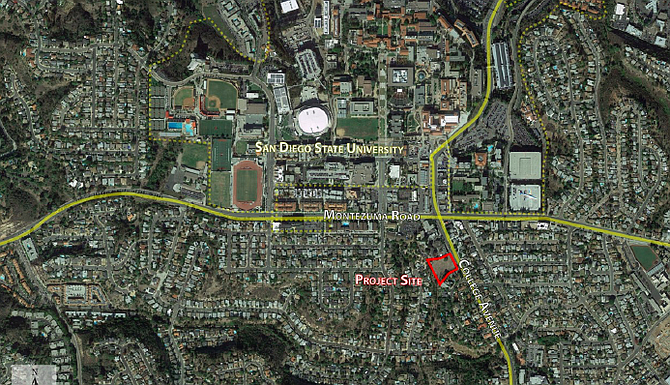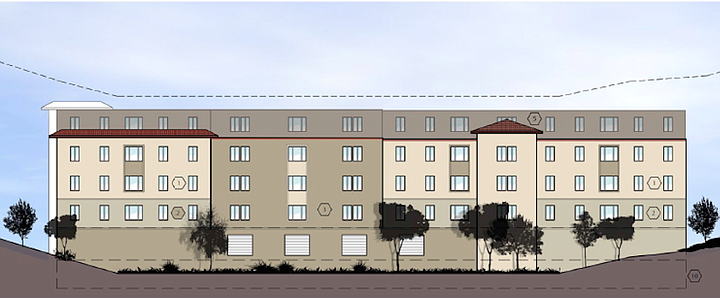 Facebook
Facebook
 X
X
 Instagram
Instagram
 TikTok
TikTok
 Youtube
Youtube

A lawsuit brought by the College Area Residents Association to stop the construction of a 91-unit quasidorm in a neighborhood of single family homes settled quietly at the end of September, according to court records and involved parties.
The residents had won a temporary restraining order and a preliminary injunction to halt construction of the building, arguing that the approval by city council was based on a 10-year-old environmental review for a much smaller sorority house that was never constructed on the 1.5-acre lot.
The settlement was announced at a College Area Community Council and Planning Board meeting Wednesday night.
"Capstone has revised the plan, reduced the number of units and beds," said Susan Hopps-Tatum. "They really did try to come up with ways to reduce impacts on our residential neighborhood."
The details of the settlement are confidential, Capstone partner Chad Izmirian said. New plans are being filed with the city development services department.
"We are pleased that this is resolved, that's all I can say," Izmirian said.
The building, called 5030, is being built on San Diego State University Foundation land, and will revert to the university in 50 years, but the university can purchase it after 10 years, according to the plan.
Classified as a multi-unit plan, the building will meet SDSU standards for student housing and be policed by SDSU cops and managed by SDSU residence managers. It will have up to four beds per apartment, and be leased by the bed. Residents must be enrolled in SDSU. But, Capstone maintains, it is not a dorm.
The planning group voted against the project in June 2015 and the planning commission also rejected it. But the city council approved the project months later.
The lawsuit named the city as a defendant, as well as Capstone. Winning the restraining order and preliminary injunction indicated that the residents association was likely to prevail at trial, Judge Tim Taylor noted.

Capstone agreed to reduce the building size on the south and west sides to put in more landscaping and to reduce the number of beds in some units, said Rhea Kuhlman, a planning board member.
"They will take it down to two stories on the west side and the south side will have the building step down to two stories instead of being a four-story wall against the lovely family homes on Cresita Drive," Kuhlman said. "They made some very sensitive changes to address the lack of transition from a residential neighborhood to a four-story building."


A lawsuit brought by the College Area Residents Association to stop the construction of a 91-unit quasidorm in a neighborhood of single family homes settled quietly at the end of September, according to court records and involved parties.
The residents had won a temporary restraining order and a preliminary injunction to halt construction of the building, arguing that the approval by city council was based on a 10-year-old environmental review for a much smaller sorority house that was never constructed on the 1.5-acre lot.
The settlement was announced at a College Area Community Council and Planning Board meeting Wednesday night.
"Capstone has revised the plan, reduced the number of units and beds," said Susan Hopps-Tatum. "They really did try to come up with ways to reduce impacts on our residential neighborhood."
The details of the settlement are confidential, Capstone partner Chad Izmirian said. New plans are being filed with the city development services department.
"We are pleased that this is resolved, that's all I can say," Izmirian said.
The building, called 5030, is being built on San Diego State University Foundation land, and will revert to the university in 50 years, but the university can purchase it after 10 years, according to the plan.
Classified as a multi-unit plan, the building will meet SDSU standards for student housing and be policed by SDSU cops and managed by SDSU residence managers. It will have up to four beds per apartment, and be leased by the bed. Residents must be enrolled in SDSU. But, Capstone maintains, it is not a dorm.
The planning group voted against the project in June 2015 and the planning commission also rejected it. But the city council approved the project months later.
The lawsuit named the city as a defendant, as well as Capstone. Winning the restraining order and preliminary injunction indicated that the residents association was likely to prevail at trial, Judge Tim Taylor noted.

Capstone agreed to reduce the building size on the south and west sides to put in more landscaping and to reduce the number of beds in some units, said Rhea Kuhlman, a planning board member.
"They will take it down to two stories on the west side and the south side will have the building step down to two stories instead of being a four-story wall against the lovely family homes on Cresita Drive," Kuhlman said. "They made some very sensitive changes to address the lack of transition from a residential neighborhood to a four-story building."
Comments